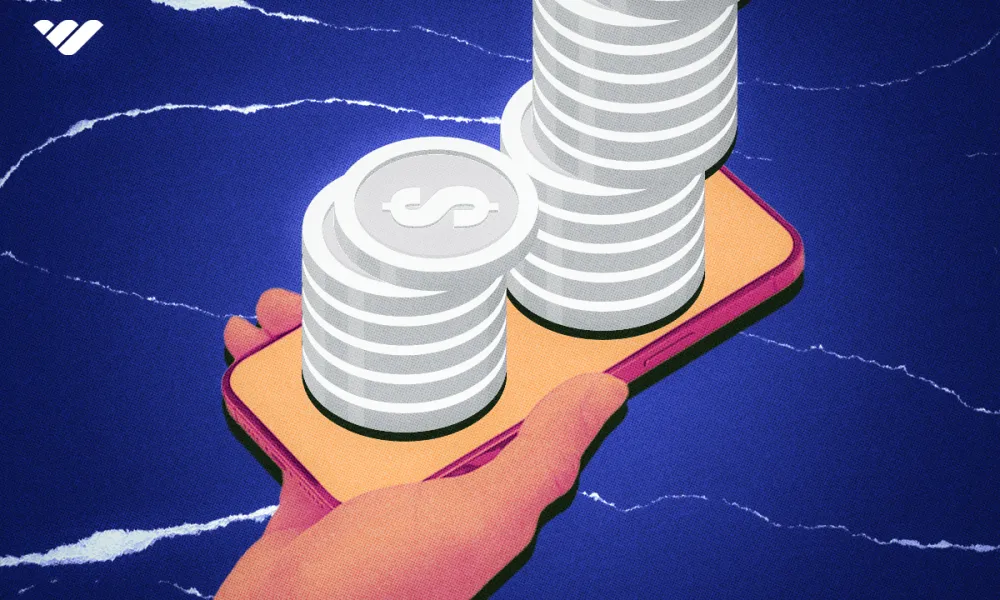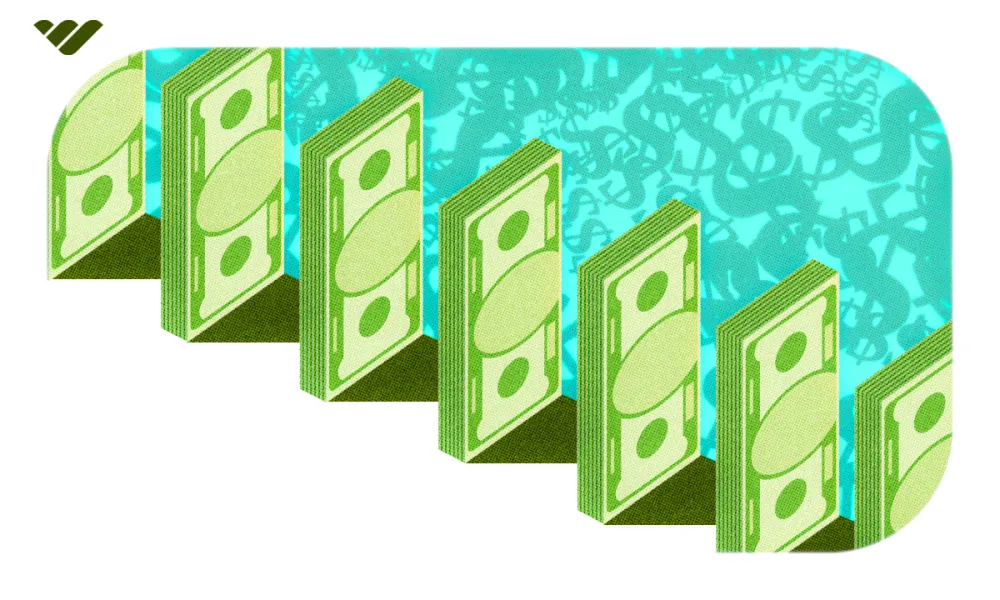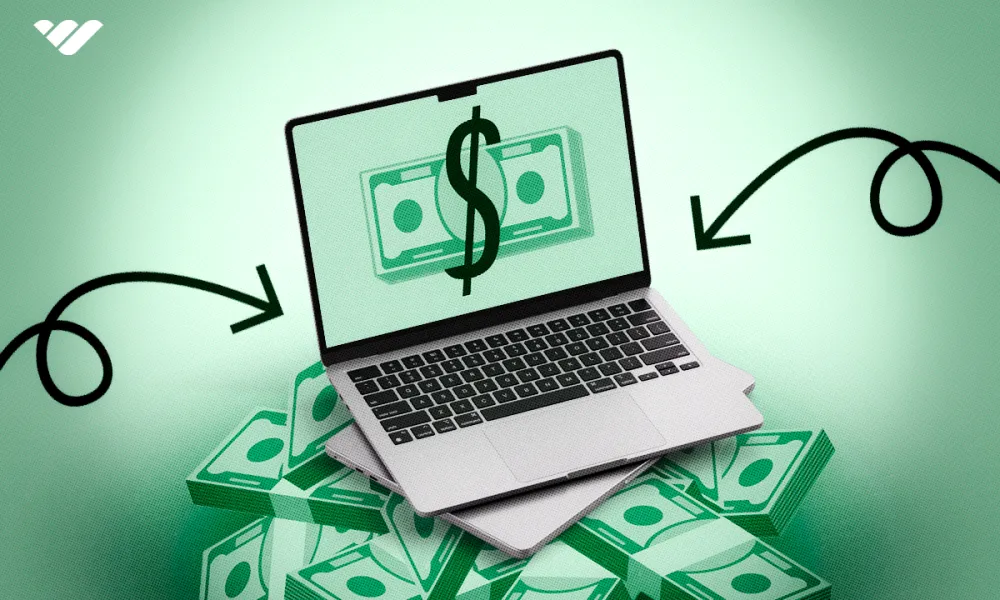Affiliate marketing is a common concept, but what is high ticket affiliate marketing? Read this article to understand what high ticket affiliate marketing is, how it works, and how you can get started today!
Key takeaways
- High-ticket affiliate programs typically pay hundreds of dollars per sale versus 5-20% traditional commissions.
- High-ticket affiliate marketing usually targets business-to-business products rather than consumer goods.
- Average high-ticket affiliate marketers earn $47,500 annually with top performers reaching six figures.
- Top affiliate programs like Whop offer 30% recurring revenue for life from creator referrals.
- Successful high-ticket affiliates need established audiences and expertise in their promoted niche.
Picture this: You have a friend who makes the best chocolate chip cookies in the world and she starts selling them. She prices them at $5 and makes you an offer—for every customer that you bring to her, she will give you $0.25.
You think to yourself “That’s 5%? That doesn’t seem like a lot if I’m making her $5!”
Well, oftentimes that’s what happens in affiliate marketing. An affiliate (the person bringing brand new customers) only gets a small percentage of the revenue they generate. But high-ticket affiliate marketing is different - same concept, much higher earning potential.
In this guide, we’re going to discuss what high-ticket affiliate marketing is, examples of programs you can join, and why you should consider getting started with it.
What is high-ticket affiliate marketing?
High-ticket affiliate marketing is when you promote products and services that have a higher commission than traditional affiliate programs. These commissions are typically hundreds of dollars, not a few bucks.
Before we dive into the thick of it, here are a few terms that you should know when discussing high-ticket affiliate marketing:
- Customer acquisition cost (CAC): How much it costs a brand to acquire a new customer
- Lifetime value (LTV): How much a customer will spend at a brand throughout their life, or, how much one customer is worth to a brand in terms of revenue
- Product-market fit: The relationship between a good for sale and the target demographic that uses it
- Commission: The percentage or flat amount that an affiliate is paid by the brand for new sales
- Affiliate: The person promoting a brand, product, or service
- Advertiser: The company that owns the product or service being promoted by affiliates
For context, in traditional affiliate marketing, the affiliates (creators, influencers, bloggers, YouTubers, etc.) are paid a percentage of how much they generate in sales. This can be referred to as “revshare” or “revenue share.” These commissions are typically anywhere from 5% to 20%.
High-ticket affiliate commissions are often worth $100s.
So, why is this the case? These affiliates are usually promoting products like apparel, footwear, accessories, or gear. And because these are items that are purchased only once in a while—versus a software subscription like Netflix or a supplement brand like Athletic Greens—the company can only afford to pay them a small percentage of the sale. There’s no recurring revenue coming in.
But, with high-ticket affiliate programs, affiliates are partnering with brands that have product-market fit, their numbers are dialed in, and their fulfillment operations are seamless. This allows the advertiser to offer a higher commission because they fully understand their CAC across all of their marketing channels and, most importantly, they know their LTV which allows them to ideally spend more to acquire that customer.
The better the product, the better the business, and the better the numbers, which makes advertisers able to give affiliates more commissions.
High-ticket affiliate marketing vs. traditional affiliate marketing
One thing to note is that high-ticket affiliate marketing campaigns are typically business-to-business products, not consumer products. This is because professional services are able to charge several hundreds of dollars per month, which isn’t the case with consumer products.
Since a tool like Slack or Shopify is used by a business that’s helping them generate thousands of dollars each month, the companies that use them are able to invest more in the software. But, the average person probably can’t afford to pay hundreds of dollars on subscriptions like Netflix or Spotify each month.
This isn’t a hard-and-fast rule, but high-ticket affiliate campaigns are typically for business customers, which means that the content your produce or ads you run should be targeted toward entrepreneurs and managers, not everyday people. Think deep, informative videos versus fun, entertaining lifestyle content.
How much you can earn with high-ticket affiliate marketing
The amount of money you can make with high-ticket affiliate marketing varies quite widely depending on factors such as:
- Commission structure: Every affiliate program has its own commission structure, and can impact the final profitability of a high-ticket affiliate marketing business.
- Niche selection: High-demand trendy niches naturally attract organic traffic. The most profitable niches for affiliate marketing can vary based on current market trends, audience demand, and competition. Some good examples of high-engaging and profitable niches are technology, finance, health and wellness, and lifestyle products.
- Mastery of marketing channels: Having deep knowledge ads strategies and paid ads programs, how to generate organic traffic, and how to build an engaged email list directly impacts your conversion rates in a positive way
But to get a more substantial idea, data presented by ZipRecruiter, a popular employment marketplace, states that, as of December 2024, the average annual salary for a high-ticket affiliate marketer in the US is $47,500, or about $22.84 per hour.
Despite that, some top-tier high-ticket affiliate marketing earners are reported to make something between $50,000 to $100,000 a year, even reaching the seven digits after a few years of work. It just shows how profitable high-ticket affiliate marketing can be, especially for those who really put work on it.
Examples of high ticket affiliate marketing programs
Let's take a look at some high ticket affiliate marketing programs in action. Here are some popular examples and how they work.
🥇 1. Whop Affiliates
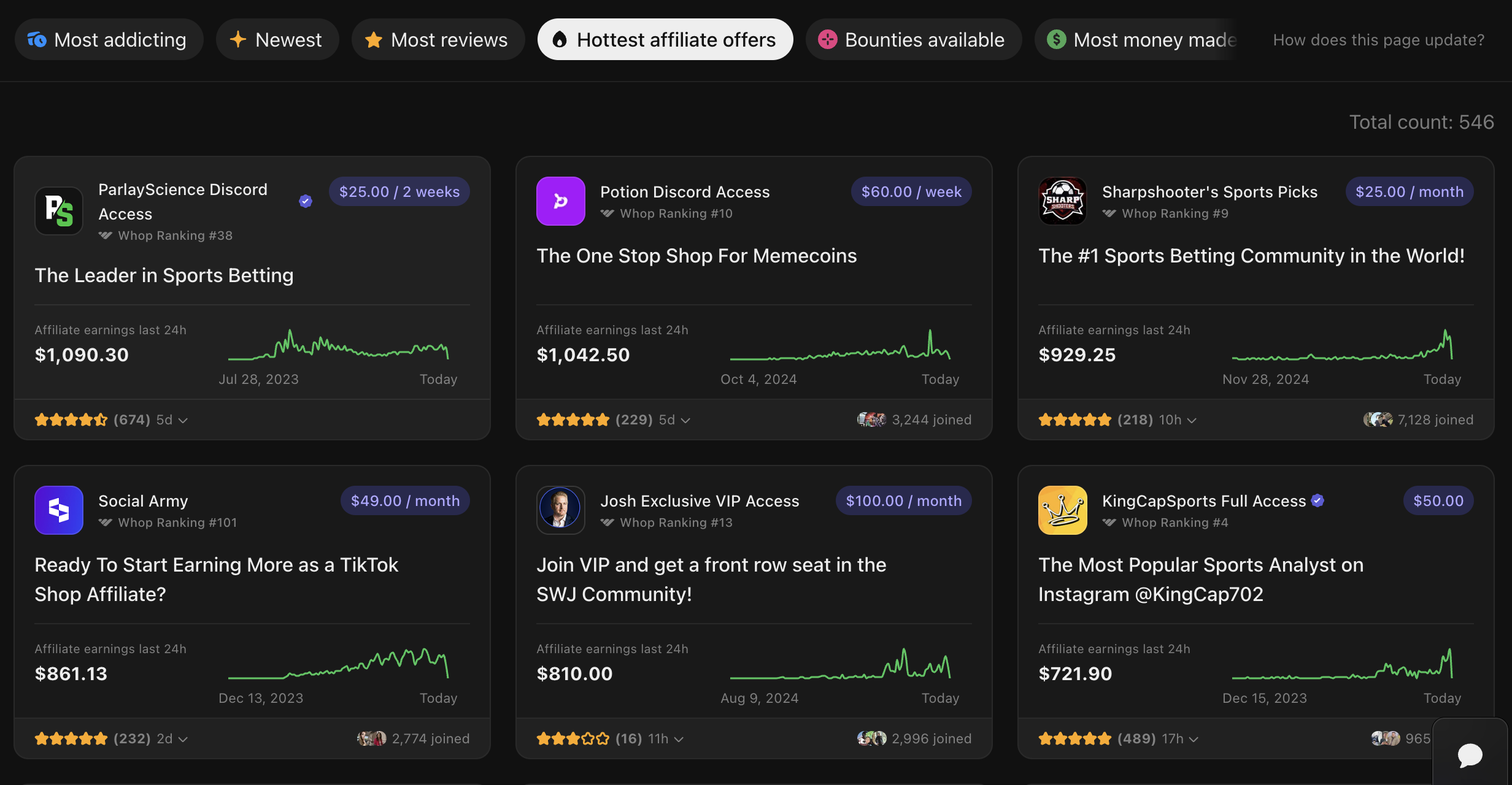
Whop is a social commerce platform made for creators, by creators. It helps thousands of creators earn over $2000 a month by selling digital products and services online, and the platform takes a percentage of creator revenue. Whop has a very generous affiliate program, where if you refer a creator to Whop, you net 30% of Whop's revenue. So when a creator sells a product, Whop takes a percentage, and you take 30% of that percentage.
The best part? This is recurring revenue for life. For every single sale the creator makes, you take a cut of that! It doesn't stop with one customer - you get paid again and again and again, for as long as the creator remains on Whop. So far, affiliates have earned more than $18 million.
Affiliate Requirements:
- Active online presence or established audience.
- Knowledge or experience with membership platforms or community-building.
- Ability to create content like guides, blogs, or videos.
Key Details:
- Commission varies per product. If you refer a creator to sign up and sell with Whop, you get 30% of Whop's revenue for life!
- Cookie duration: 1 day
Payment details: Supports payments by direct deposit to your bank account
2. Shopify Affiliate
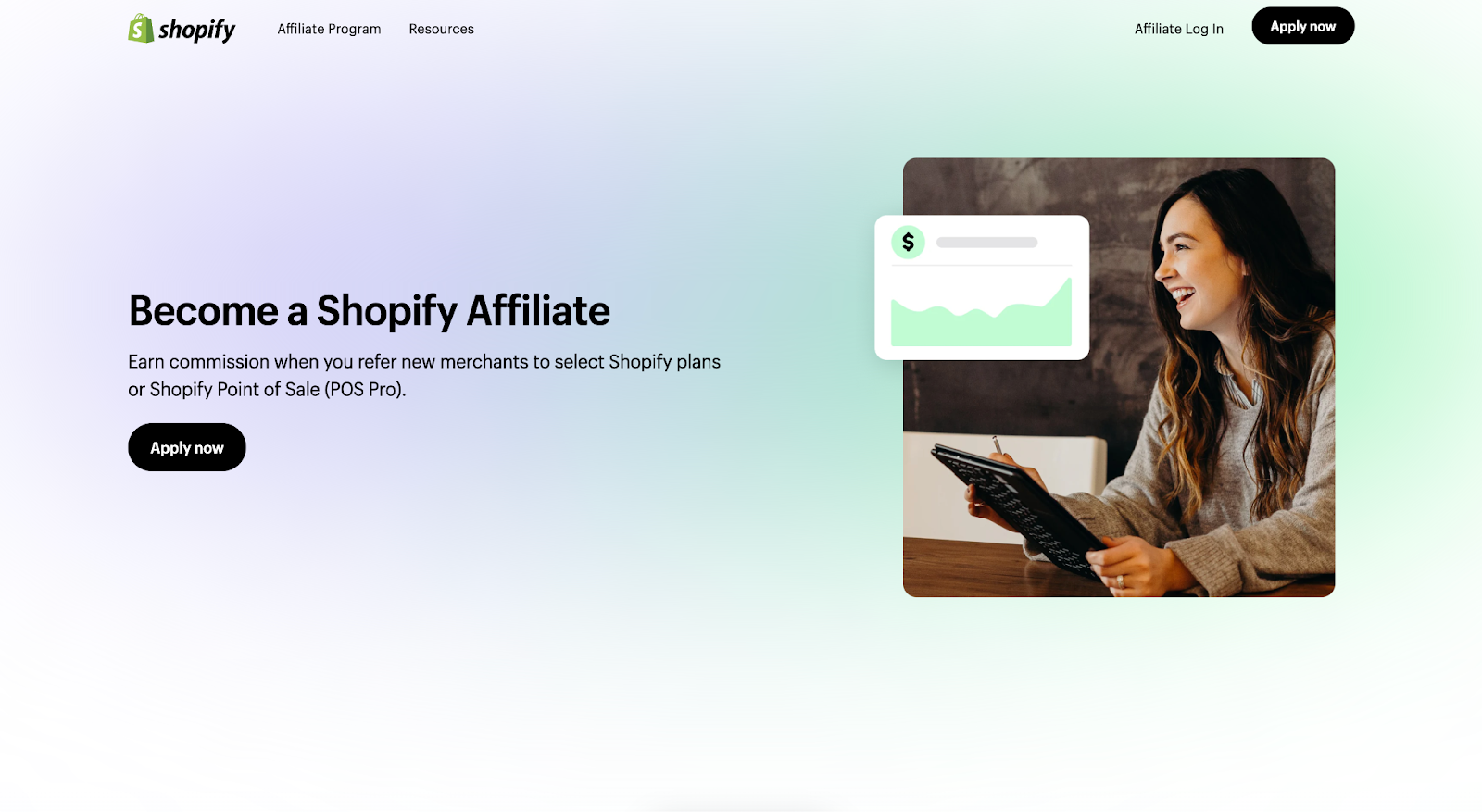
The ecommerce giant allows entrepreneurs to build their own websites and sell products online. They make money through a monthly subscription and credit card processing fees, which allows them to pay affiliates great commissions. Commissions range from $25 to $150.
Affiliate requirements:
- Have your own active website with an established audience
- Knowledge to create original content such as online courses, blog posts, videos, or guides
- Have experience with commerce, entrepreneurship, Shopify, or other ecommerce platforms
Key details:
- Fixed commission that varies by merchant location
- Commission ranges from $25 to $150 for full-priced plan referrals, and up to $500 for POS Pro referrals
- Biweekly payment in USD via bank account or PayPal
- Cookie duration: 30 days
3. Semrush
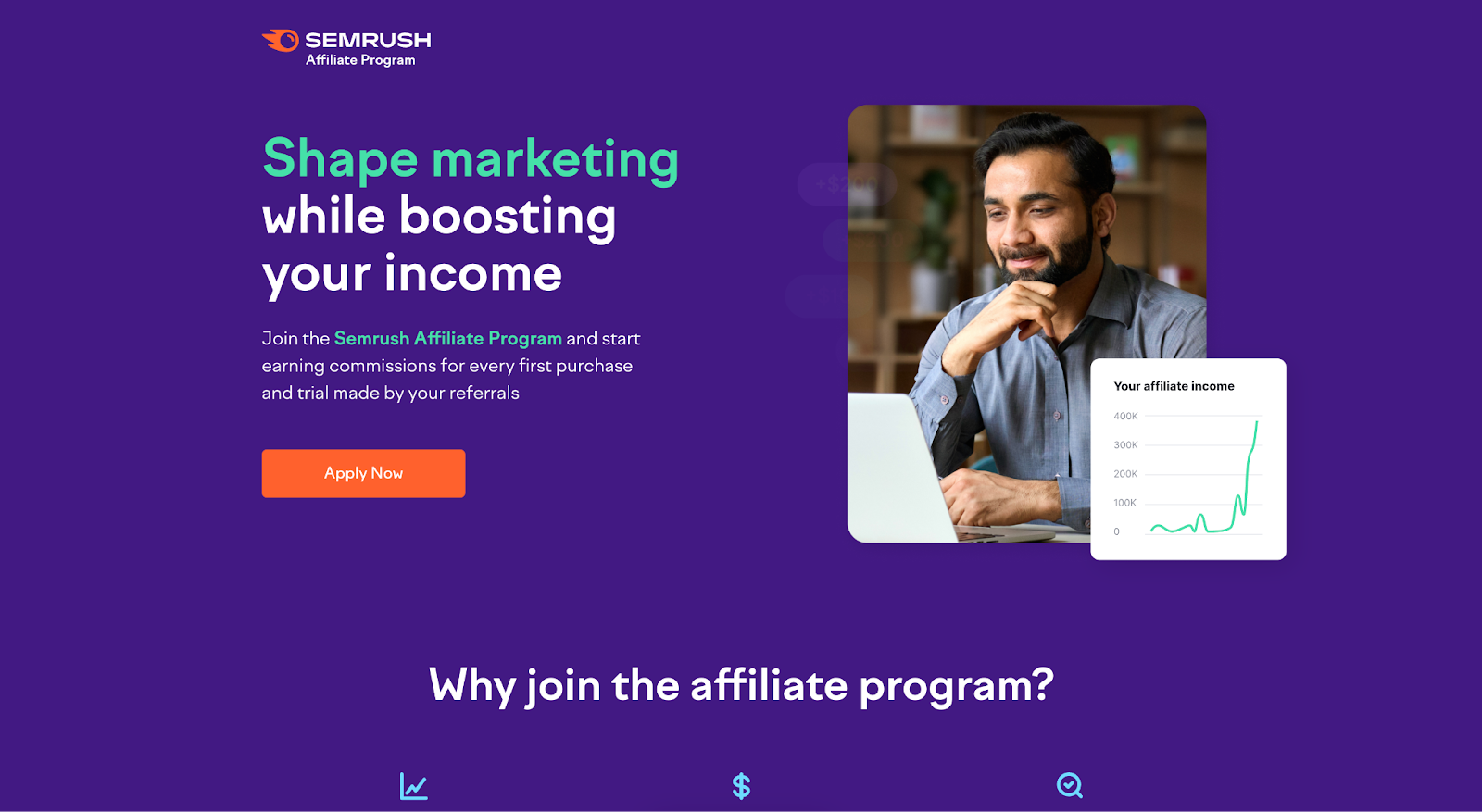
This software helps bloggers do keyword research to generate traffic to their site from search engines. Customers who use Semrush are able to pay large amounts for the tool because their whole business revolves around SEO. Commissions range from $10 per trial sign-up to $200 per paying customer.
Affiliate Requirements:
- Active website or social media presence in digital marketing or SEO niches.
- Must disclose marketing methods; PPC campaigns are allowed under specific guidelines.
- Preference for affiliates familiar with online marketing tools.
Key Details:
- Commission: $200 per subscription sale, $10 for new sign-ups.
- Payouts via PayPal.
- Cookie duration: 120 days.
4. HubSpot
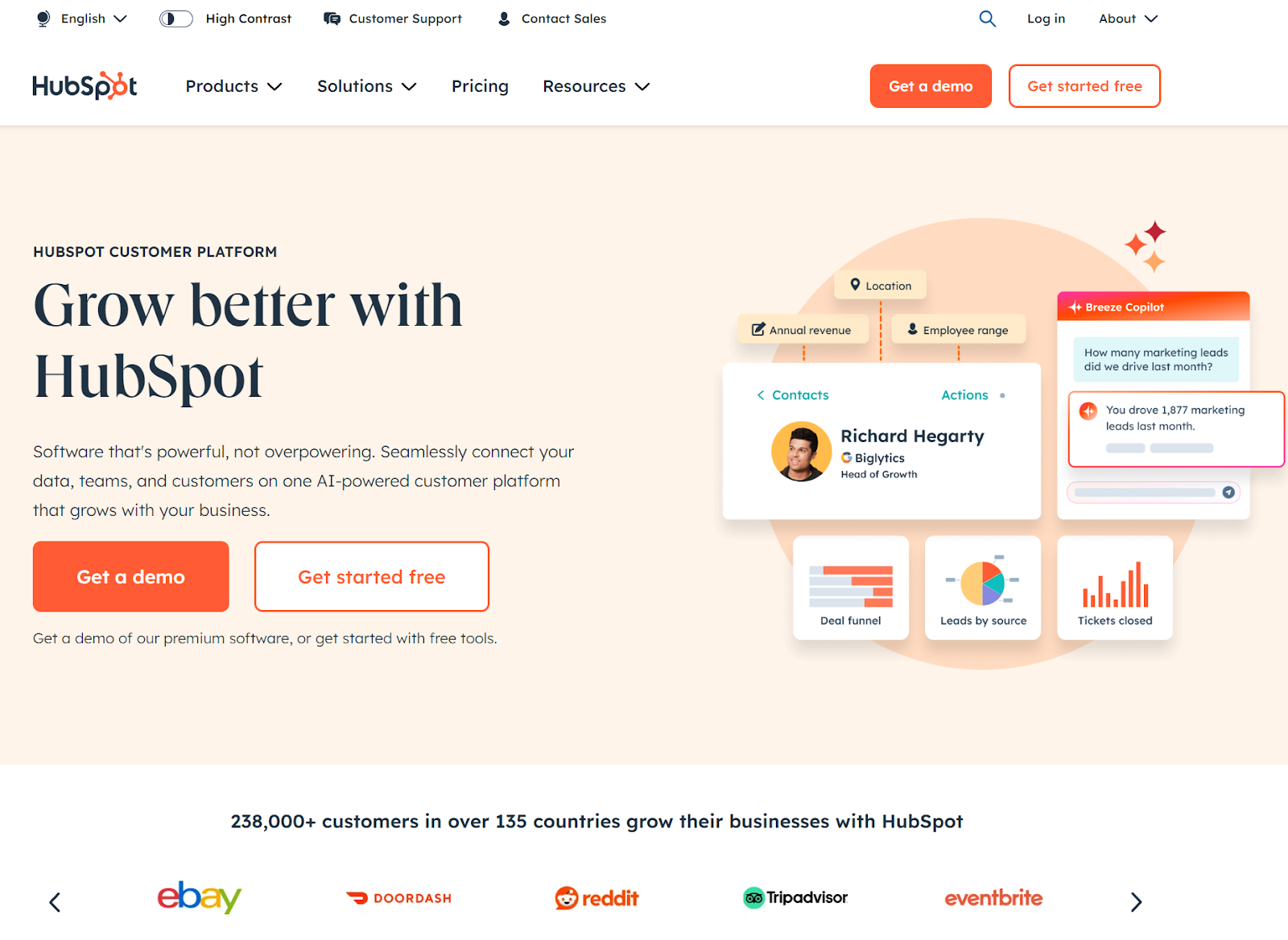
With over 238,000 customers in over 135 countries, HubSpot offers many tools to help marketers capture leads, manage their ongoing relationships, and steer consumers through purchase. It's a versatile tool that combines many features powered by AI for maximum optimization of any processes.
In terms of commissions, the affiliate program pays 30% + recurring commission for up to one year, plus bonus options for top performers.
Affiliate Requirements:
- Must run an active blog, website, or audience with an interest in business software.
- Experience or expertise in inbound marketing, CRM, or related niches.
- Content creation capability (e.g., blogs, tutorials).
Key Details
- Commission: 30%+ recurring commission for up to one year, plus bonus options for top performers
- Cookie duration: 180 days
- Affiliate network: Impact
- Payment: Supports payment by direct deposit or PayPal, with a minimum balance of $10
5. ClickFunnels
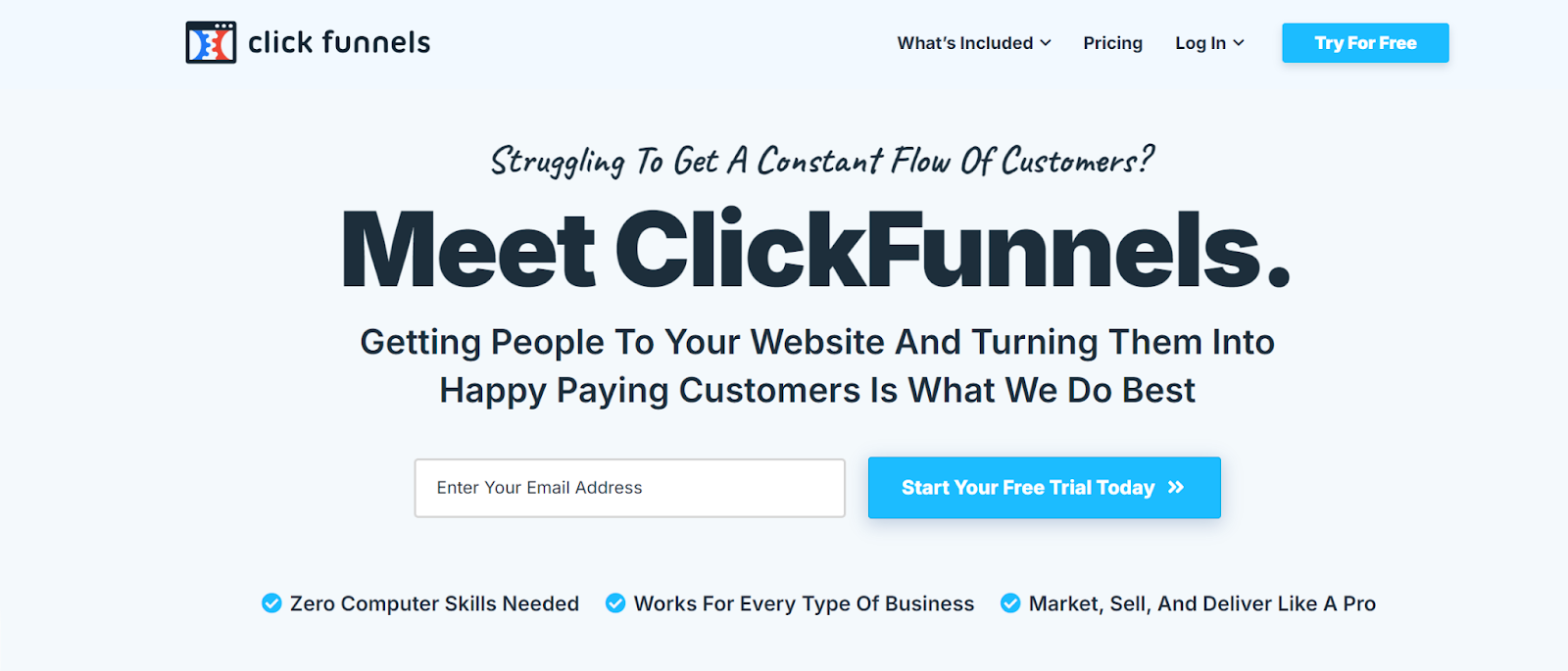
ClickFunnels helps entrepreneurs create their own sales funnel, which improves conversion rates by improving all the journey a consumer partakes from discovering the product to finally buying it. The affiliate program pays 30% recurring commissions on all sales, for as long as a referred account is active, with additional bonuses for upsells, and when specific challenges are met.
Affiliate Requirements:
- You must own a website or have an audience relevant to ClickFunnels' niche (entrepreneurs, marketers, and ecommerce specialists).
- Create original content demonstrating ClickFunnels' features.
- Comply with ClickFunnels' promotional guidelines.
Key Details:
- 30% recurring payout on all active accounts and price tiers; plus bonuses for upsells and challenges
- Cookie duration: 45 days
- Payment details: Payouts are held for 30 days as a cooling-off period in the case of refunds. To receive your payouts, you’ll need to set up an account through a third-party app called Tipalti, which you can link to PayPal or directly to your bank account.
6. Amazing Selling Machine

The Amazing Selling Machine (ASM) is an ecommerce training program with over 35,000 students that teaches wannabe entrepreneurs how to sell on ecommerce sales platforms like Amazon, eBay, or Etsy. The program pays a commission of 50%.
As an affiliate you can promote three main offerings on ASM:
- The brand’s flagship course (which also names the program) Amazing Selling Machine
- Membership to the Amazing Academy
- Tickets to SellerCon: the brand’s annual conference
Affiliate Requirements:
- Have experience with ecommerce and marketplaces like Amazon, and eBay.
- Your own dedicated audience in entrepreneurship or online business.
- Must register for their affiliate launch promotions.
Key Details:
- Commission rates are up to 50% per referral.
- Bonus commissions for high-performing affiliates.
- Cookie duration: 60 days.
7. BigCommerce affiliate
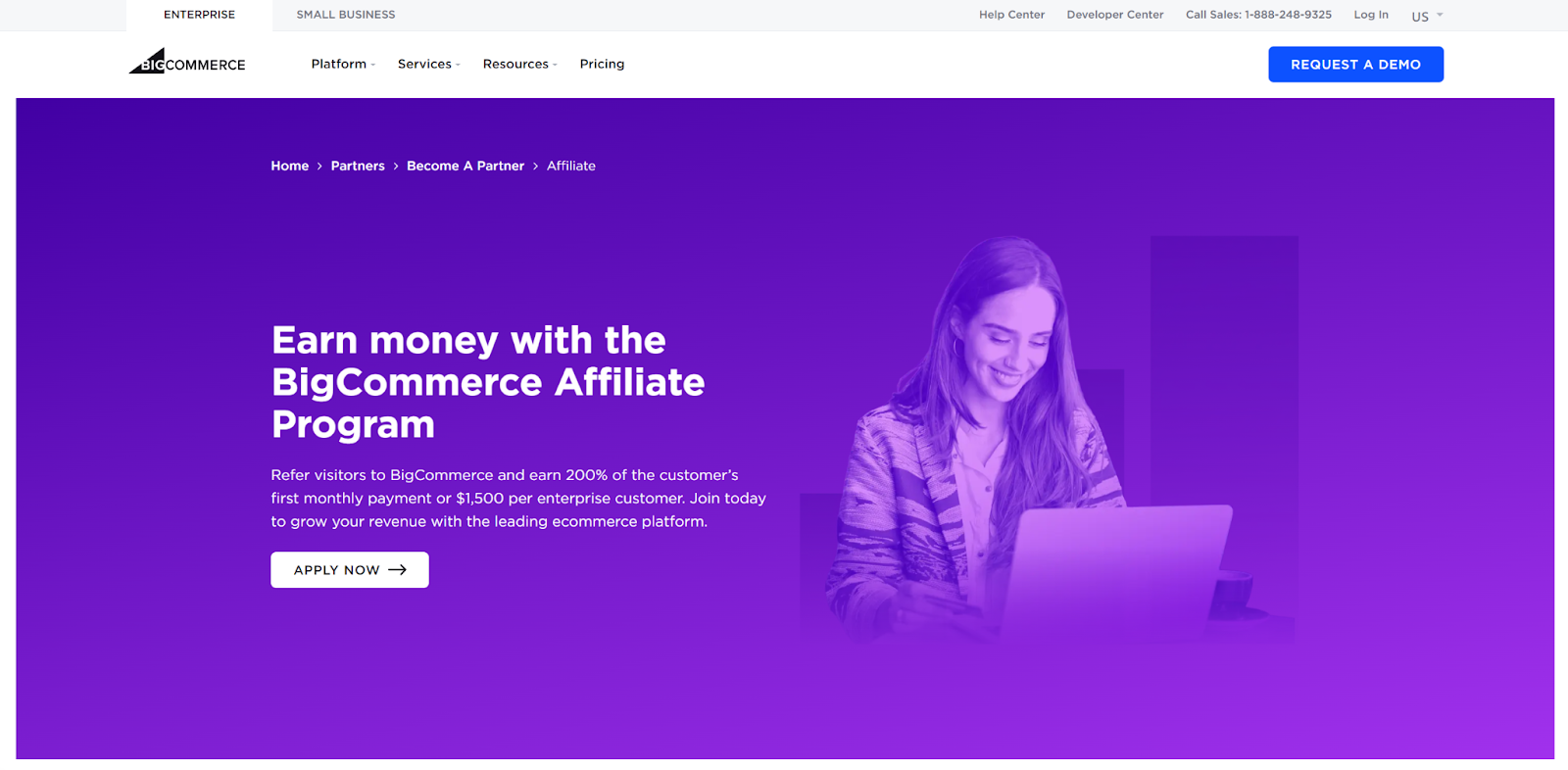
BigCommerce is a platform for building and managing high-conversion ecommerce websites. It is quite similar to Shopify in terms of creating an online store, but BigCommerce focuses more on B2B and B2C sales at an enterprise level.
This is what makes its affiliate program one very lucrative, with the possibility of earning 200% of the customer's first monthly payment or $1,500 per enterprise customer.
Affiliate Requirements:
- Have a website or content platform focused on ecommerce, SaaS, or technology.
- Knowledge of or experience with online business platforms, and enterprise-level ecommerce platforms.
Key Details:
- Commission: 200% of the referred customer's first monthly payment (up to $1,500 per referral).
- Recurring revenue option for enterprise referrals.
- Cookie duration: 90 days.
8. DreamCloud
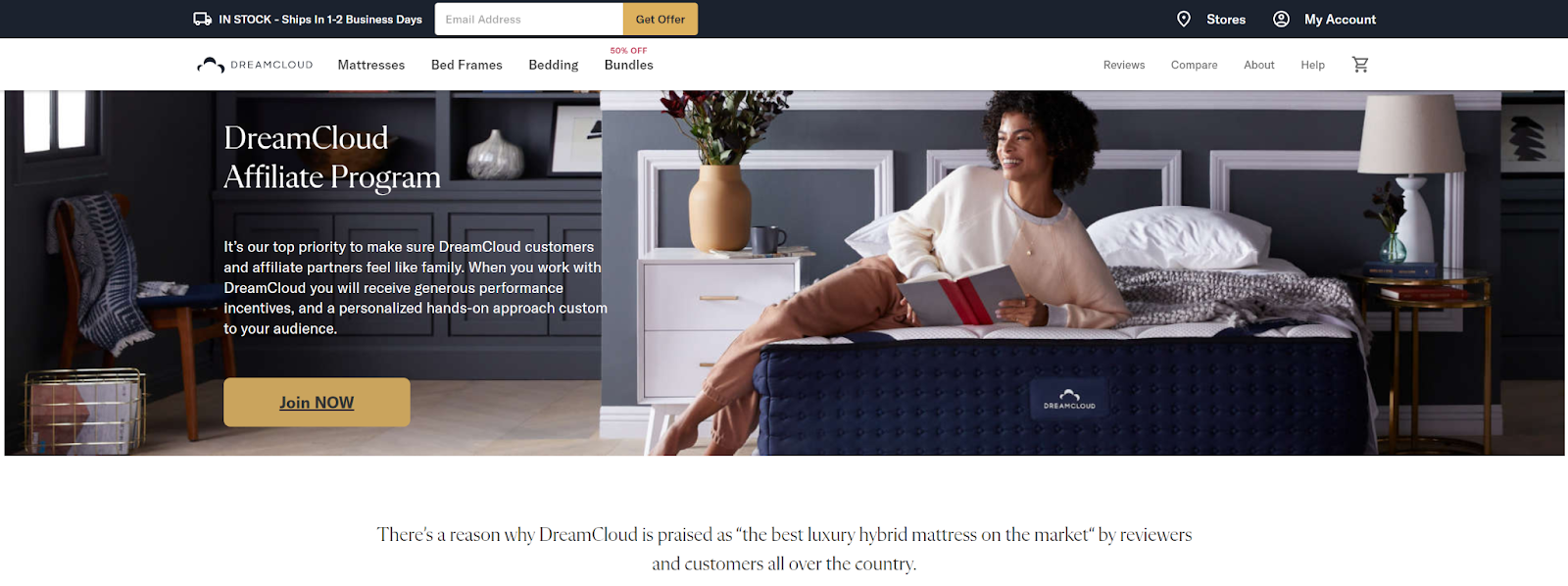
It may seem a bit unusual for beginners to see a DC company focused on mattresses and lifestyle offering an affiliate program, but DreamCloud actually has one of the most lucrative high-ticket affiliate programs in its segment—paying $150 per mattress sale plus a 12% bonus on accessories. Definitely an income opportunity not to be overlooked.
Affiliate Requirements:
- Have a website or blog relevant to home, sleep, or lifestyle topics.
- An established traffic and audience engagement on your platforms.
Key Details:
- Commission: Up to $150 per mattress sale.
- Payment monthly via direct deposit.
- Cookie duration: 120 days.
9. Smartproxy
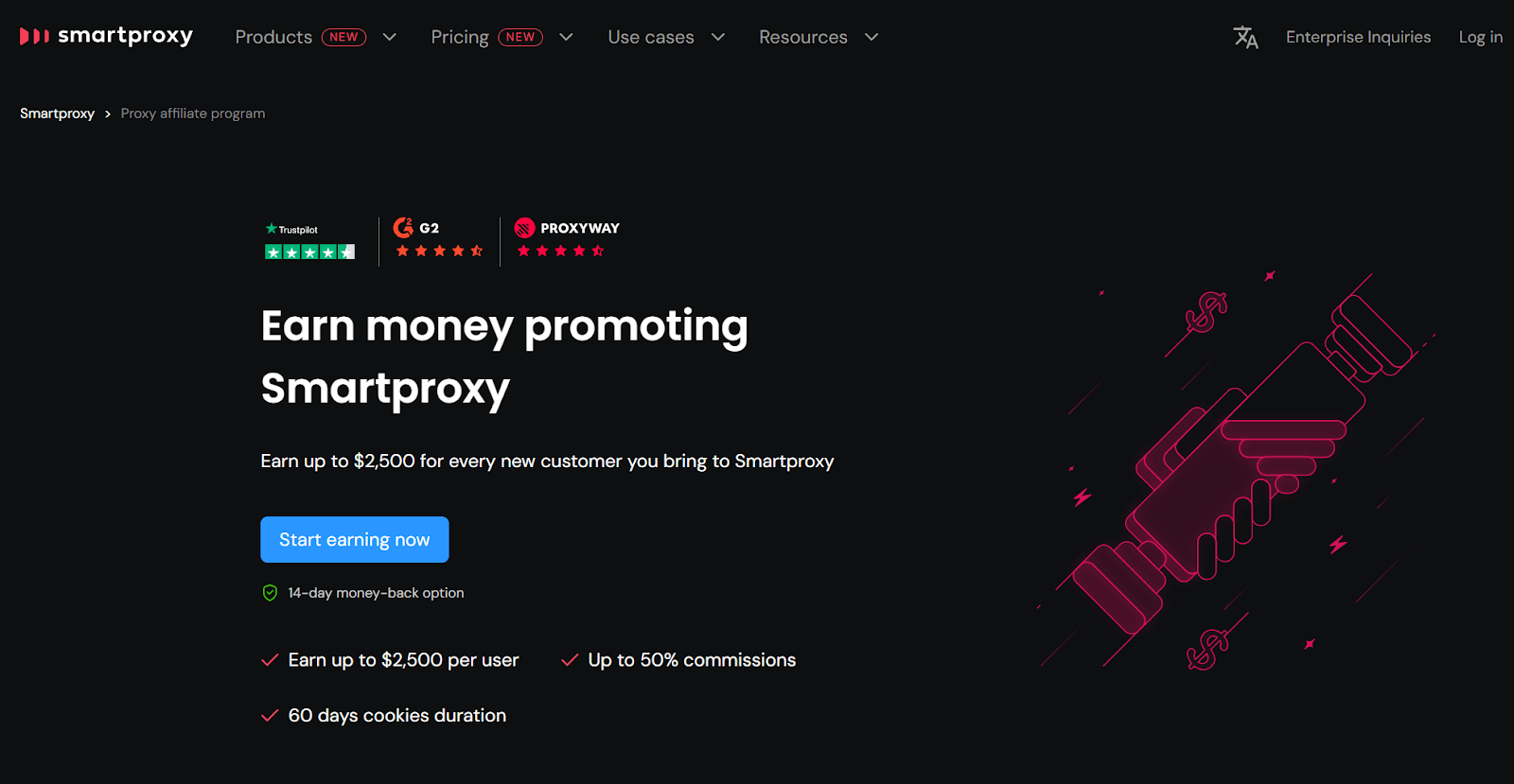
Smartproxy is a residential proxy network (proxies being servers between a user and the web page they want to access) that offer businesses a target data service, allowing them to verify ads, automate social media, and more. On Smartproxy’s affiliate program, you can earn up to $2,500 for every new customer you bring to the company.
Affiliate Requirements:
- A website, blog, or social media channel relevant to proxies, tech, or digital tools.
Key Details:
- Commission can go up to 50% per sale.
- Payments are made monthly.
- Cookie duration: 60 days.
10. Teachable affiliates
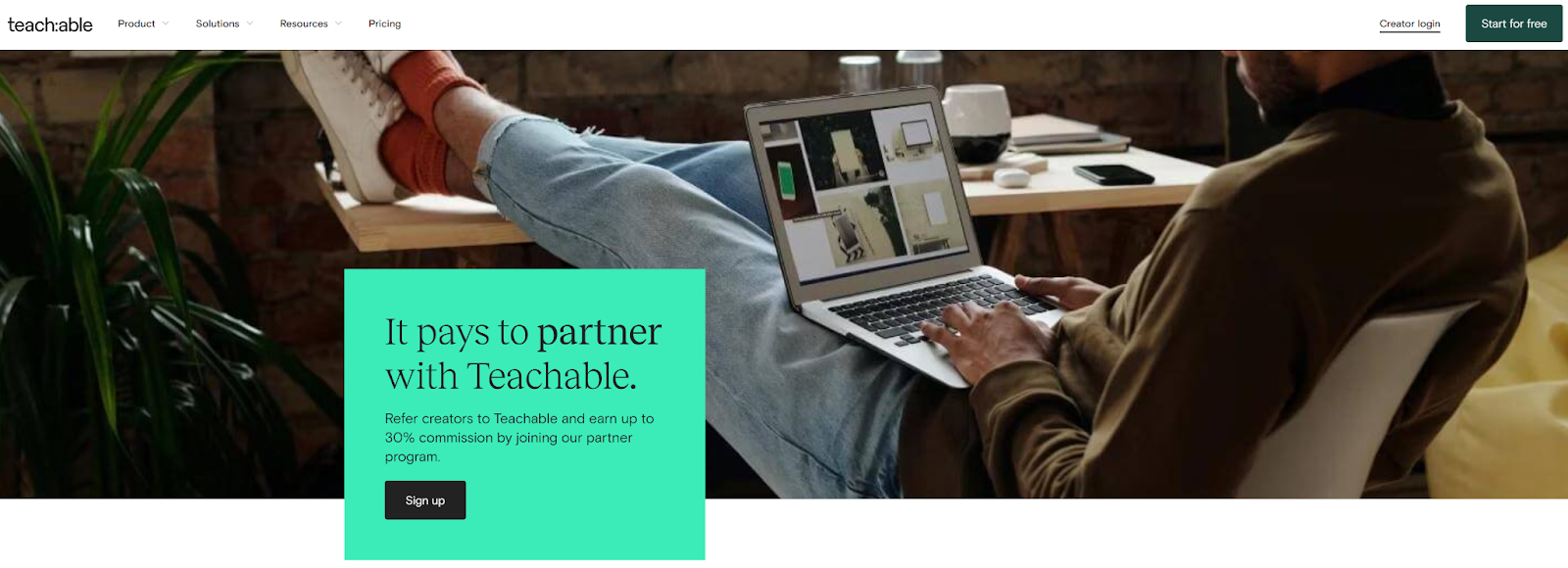
Teachable is a popular platform that helps businesses create and sell educational content like online courses, guides, ebooks, and other digital products. With Teachable's affiliate partner program, you can earn up to 30% commissions when referring creators to the platform.
Also, according to Teachable, affiliates can earn $450 per month on average, with top performers reaching over $1,000 in profits. Combine this with the fact that the affiliate program includes a recurring payment, then you have one incredible source of passive income.
Affiliate Requirements:
- Have an active website or audience focused on online courses, education, or entrepreneurship.
- Being a content creator who uses Teachable or similar platforms.
Key Details:
- Commission: 30% recurring for up to 12 months.
- Payment via PayPal.
- Cookie duration: 90 days.
11. GetResponse
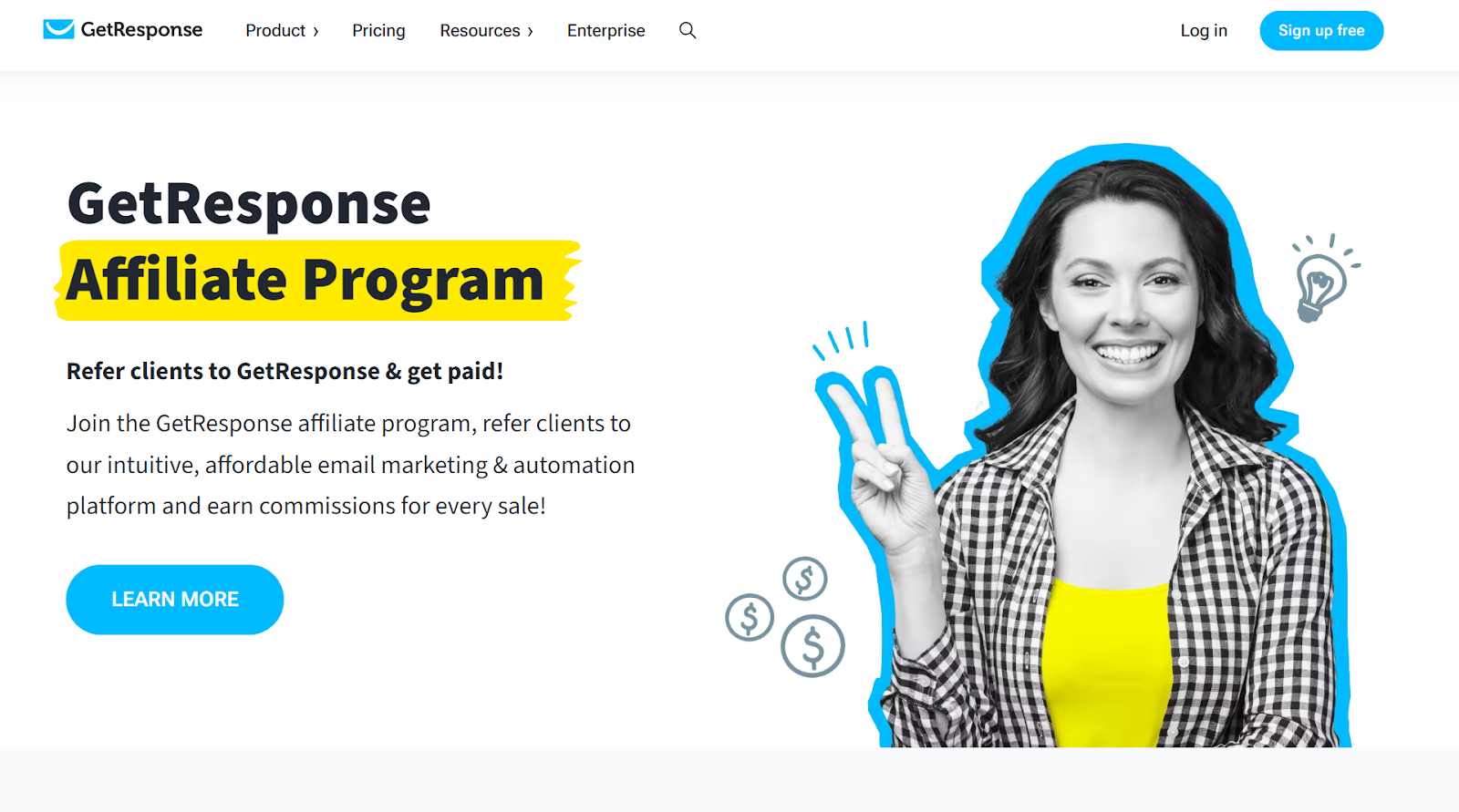
GetResponse is an intuitive and affordable email marketing platform that allows users to automate email marketing campaigns. When you join GetResponse’s affiliate program, you can earn money with two methods: through the recurring and bounty programs.
The affiliate recurring program gives you a continuous commission that starts at 33% every month, but can go up to 50% depending on how many sales you generate in the semester.
The affiliate bounty program offers a payment of $100 for the referral of email marketing products and $150 for content monetization packages offered by the platform.
Affiliate Requirements:
- Have an active blog, website, or other marketing channels in digital marketing niches.
Key Details:
- Commission: starts at 33% on the affiliate recurring program, or $100 on the bounty program
- Payments via PayPal or other methods.
12. FreshBooks

Despite not being in a very prominent niche—being an accounting software for small-businesses—FreshBooks’ affiliate program presents itself as one of the easiest to make money with.
Your referrals can earn you up to $10 per free trial, with a bonus of up to $200 per paid subscription. This means that your referrals don’t have to spend a single dollar on the platform for you to make money, just sign up for the free trial.
Affiliate Requirements:
- Have an active blog, website, or YouTube channel with focus on accounting, small businesses, or freelancing audiences.
Key Details:
- Commission: $10 per free trial sign-up, $200 per paid customer.
- Payment via bank transfer or PayPal.
- Cookie duration: 120 days.
13. Fiverr
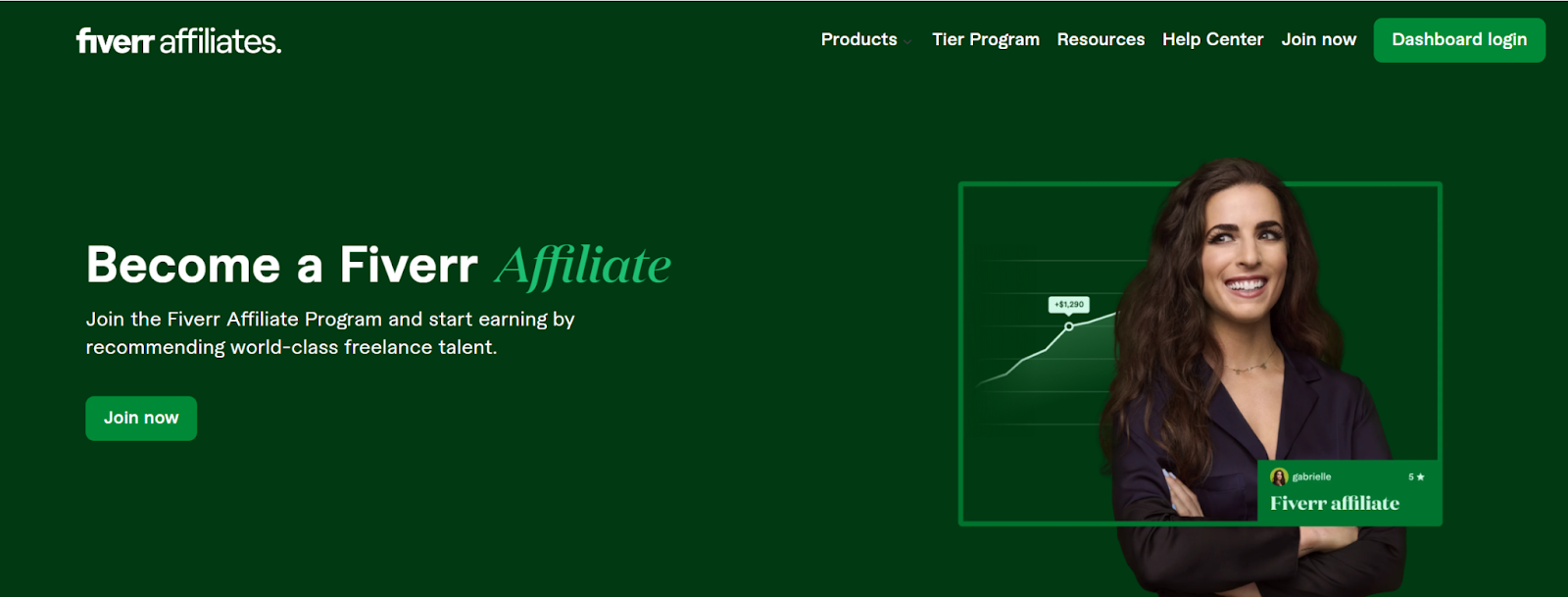
Fiverr is a website that works as a marketplace for freelancers and service providers in general. It’s very popular among content creators and features services across more than 700 categories, being one of the largest on the internet. It’s so big and recognizable that it would be hard to imagine it not having an affiliate program.
On Fiverr you can earn instant commissions ranging from 25% to 100% of the customer's first order, plus a 10% revenue share from all future orders placed by that same customer in the first 12 months after the first order.
Affiliate Requirements:
- Have an active website, blog, or social media platform.
- Interest in digital services, freelancing, or entrepreneurship.
Key Details:
- Commission: 25%—100% per sale, depending on the referred service.
- Payment via PayPal or bank transfer.
- Cookie duration: 30 days.
Looking for more programs? Check out these high-ticket affiliate programs to turbocharge your earnings.
Pros and cons of high-ticket affiliate marketing
Now that you know what high-ticket affiliate marketing is and how it works, let's look at some of the best and worst parts of this type of marketing.
Pros:
- Higher payouts
The biggest benefit of high-ticket affiliate marketing is that it has a… high ticket. Rather than getting a small percentage of the revenue you bring in, you typically receive a set flat amount in the $100+ range. This means that you can get fewer customers and still make a good income. - More established brands
Because the advertisers that you’re working with have a fully developed sales “funnel” (the process of bringing in a new customer), they have more systems and operations to help you. You may be working with startups, but they have a strong foundation to help your marketing efforts scale. This makes your campaigns run smoother, you’ll get paid faster, and ultimately, you’ll make more money. - Potential for long-term commissions
Some companies that are on a subscription basis will offer affiliates not just a one-time commission, but a recurring payment for each month that the customer stays on. This means that you could bring a customer in one time but still get paid each month. - More niche content
Most high-ticket campaigns will be in specific verticals like ecommerce or productivity. The content you create has to be tailored to people who would find these tools useful.
Although it may make things harder or more targeted at first, if you’re truly a subject matter expert then you’ll enjoy making this type of content because it’s something that you’re well versed in. Not to mention, fewer people will be able to compete with you. - Multiple options to monetize
Not all payouts and conversions are just when a customer signs up for a subscription. Some events, such as someone signing up for a free trial, could still be counted as a conversion. Alternatively, conversions may not be tracked until a customer does a specific action such as “gets 10 sales” or “stays on for six months.”
The more difficult the event, the higher the payout. But regardless, you have more options. Campaigns that only require someone to enter their contact information or sign up for a trial are referred to as “cost per lead” (CPL) campaigns and are usually for more expensive products like a mattress or car.
Cons:
- Higher customer acquisition costs
Because the price (or average order value) of the product is higher, you need to spend more money or time to acquire them. You have to create more content or spend more money on ads so that your target audience sees the product multiple times. They probably won’t hit “buy now” the first time they see something. - More competition
More money, more problems. Since the opportunity for higher payouts is in this form of affiliate, some of the best marketers and operators are trying to cash in. If you’re a complete beginner, take this into consideration. Additionally, advertisers may not let you join their program as an affiliate if you don’t have a track record of success promoting other people’s products. - Expiration on programs and lowered payoutsOne of the most overlooked aspects of high-ticket affiliate programs is the lifespan of campaigns. The earlier a business is into its journey, oftentimes the more money it will be willing to spend on commissions because it’s still in the phase in which they’re looking for early customers and product-market fit.
What this means is that as the company matures, they’ll scale back on how much commission they offer because they have a more omni-channel marketing strategy and better brand recognition. This is always going to happen—there could be cases in which a company ends up paying more the more it grows, but this is what happened with Shopify, for example.
YouTubers who were early to promote Shopify as the best ecommerce tool received much more lucrative commissions compared to today’s rates. - Longer consideration cycles
The customer that purchases a high-cost B2B software is going to take a longer time to become a customer than someone who is simply buying a new t-shirt. This could cause a few problems: First, tracking could be more disjointed, so you could lose credit for sales; second, your feedback loop is longer so you don’t know exactly what marketing angles are working more than others; and third, you could potentially run into cash flow problems if your traffic source requires paid media.
High-ticket affiliate marketing for beginners: How to start earning big!
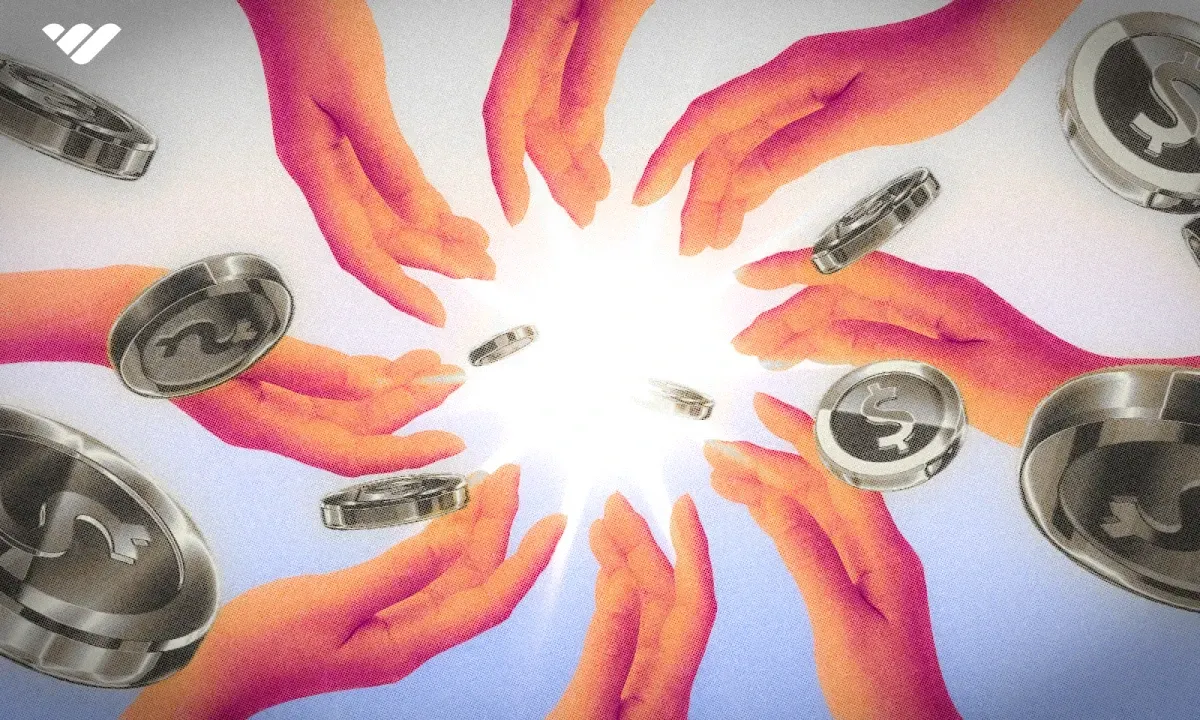
Here are a few simple steps you can take to get started with high-ticket affiliate marketing:
Grow (or Buy) an audience
In order to get customers, you need to have traffic. Traffic can be generated in two forms: Organic and paid. Organic traffic is typically found through posting content on a platform like YouTube or TikTok and paid traffic is through ads run on Google, Instagram, and more.
Organic traffic is cheaper, but it takes your time. Paid traffic costs money by definition, but you can reach a much greater scale. Consider posting content within a specific niche that you have a lot of knowledge on.
Explore & apply to affiliate marketing programs
Once you’re getting eyeballs, it’s time to start looking at different affiliate programs and applying. You can find different advertiser affiliate programs on platforms such as Impact, Commission Junction, and Awin. You can apply to join the program on these websites, which will also manage your payments.
Create content across multiple channels
Now that you’ve joined a few affiliate programs and have at least one channel working for you, you should start to diversify. You never know when a platform could make a change to the algorithm that could lose you followers or reach, so it’s best to be active on multiple platforms to ensure your business’s sustainability.
Reinvest your profits
You’ve started generating sales, but what do you do next? You’re likely not reaching your full earning potential at this stage yet, so one of the best things you can do is reinvest the money that you’re making back into your business. This could look like starting ad campaigns for other advertisers or hiring a team to help you make more content.
Repeat and scale
At this point, you may have several campaigns that are working and you’re looking to make even more money. Now is when things really get fun! Use the same things that got you to this point to scale even higher. Join more programs, create more content, and make more money.
Looking to earn big with affiliate marketing? Look no further than Whop!
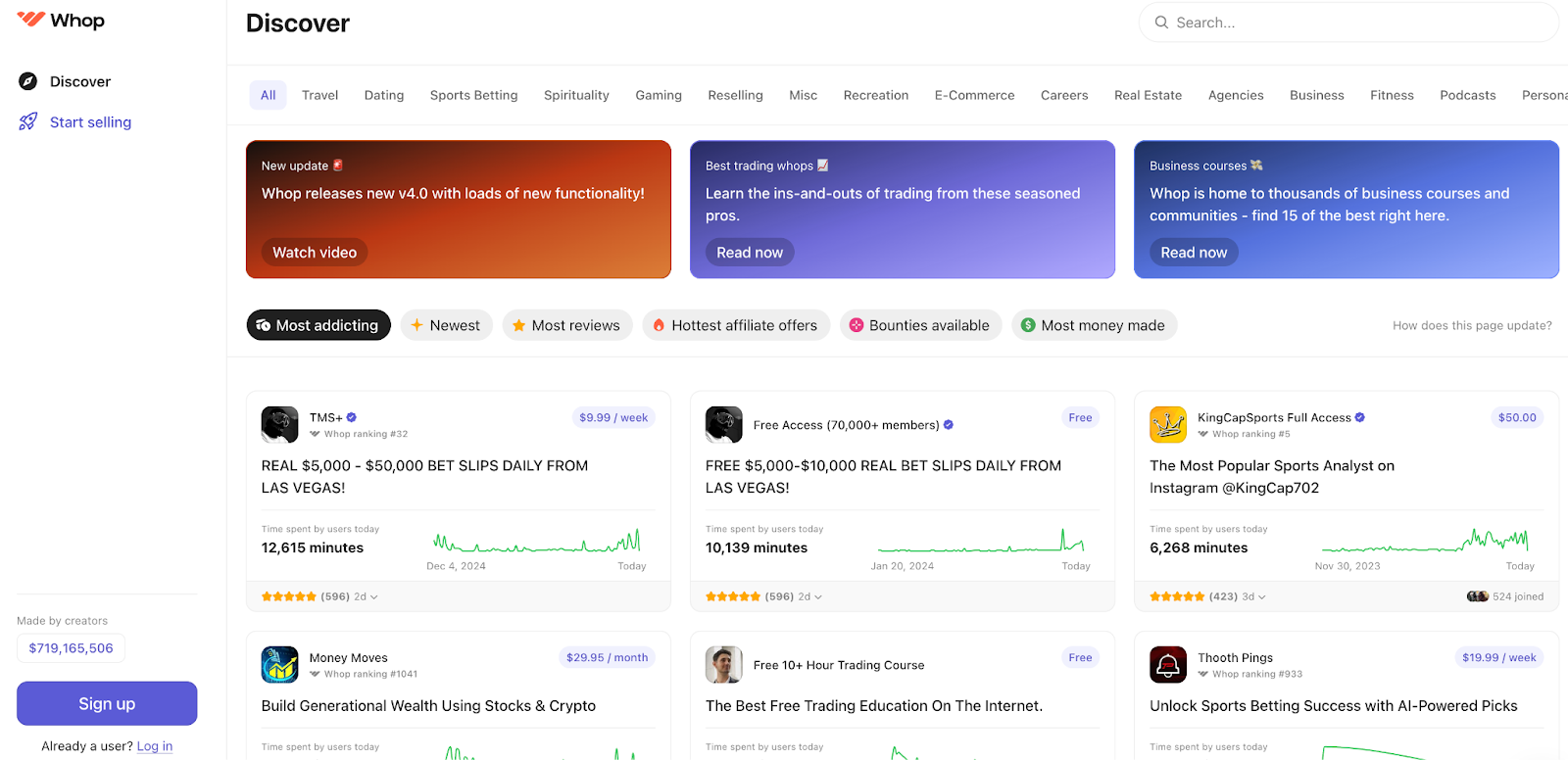
If you like the idea of making money online without the need for an office, reporting to a boss, or constantly having to communicate with clients, then Whop is the place to start.
Whop's affiliate offers can make you a lot of money. Just head to the Discover page and check out 'hottest affiliate offers'. Some of the top whops have an average affiliate earning of over $1000 in just 24 hours.
And, if you're just starting out then we have thousands of communities and courses that will help you become a better affiliate marketer. Check out the Business category of Whop to find affiliate marketing coaching, communities, and courses.
High-ticket affiliate marketing FAQs
How much do high-ticket affiliate marketers make?
There’s no set amount that high-ticket affiliate marketers make. It all depends on what programs you join, how much you can scale your campaigns, and how savvy you are at marketing. Some high-ticket affiliate marketers are making zero dollars while some are making millions.
What are the most popular high-ticket affiliate marketing programs?
Some of the most popular high-ticket affiliate programs are HubSpot, WP Engine, Shopify, and Kinsta. These are all technology products that charge business customers a high rate to use them on a monthly basis.
Who is the most successful affiliate marketer?
It’s almost impossible to definitely recognize the most successful affiliate marketer, as most “super affiliates” aren’t public and the most successful affiliates don’t disclose their revenue. However, some of the biggest names in the space are Anthony Sarandrea, Adam Young, Matt Diggity, and Chris Erthel, to name a few.
Why should I start high-ticket affiliate marketing?
High-ticket affiliate marketing isn’t for everyone, but if you have a keen understanding of software products and a large following on a social media following, or can efficiently generate traffic, you should consider high-ticket affiliate marketing.









![80 remote side hustles to make money from anywhere [2026]](/blog/content/images/size/w1000/2025/11/tablet-designer-home-opt.webp)

